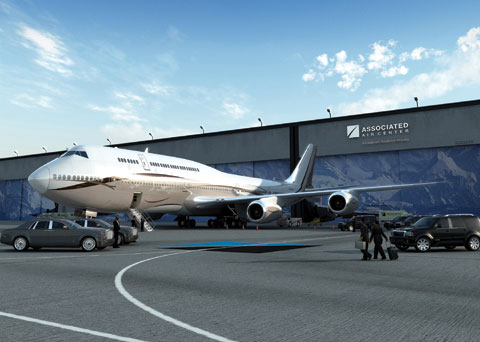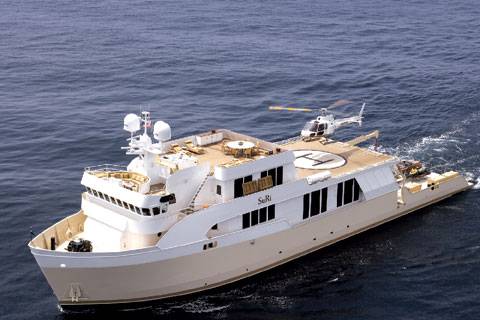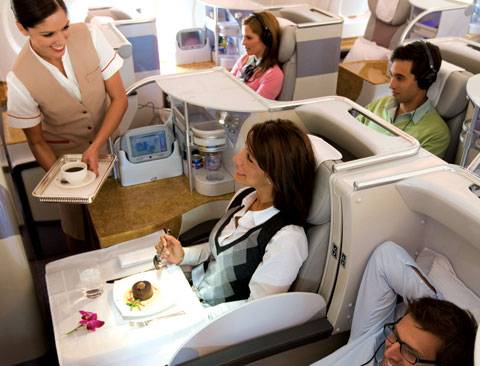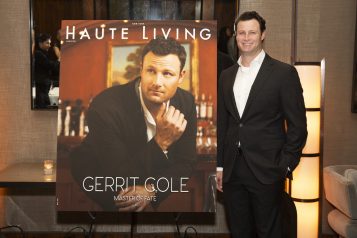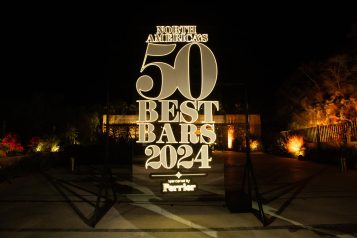With manmade islands built in the shapes of palms, glistening glass towers of record-breaking proportions, and endless 360-degree views as far as the eye can see, Dubai seems built for the aerial view. The city is in the midst of a nearly unprecedented construction boom right now and it is not too difficult imagine the emirate looking like something out of The Jetsons in coming years. Many features of the new constructions take into account just how airborne the city’s denizens will be.
When Prince Alwaleed bin Talal purchased the Airbus A380 Sky Palace, Edése Doret, the New York-based interior designer who headed the project, garnered major headlines for himself and his firm.
Helicopters in particular seem well suited to the cutting-edge lifestyle that Dubai’s future promises. It could well be that helicopters supplant earthbound conveyance as the transportation of choice for the city’s inhabitants. Just about every one of the major developments is equipped with a helipad. If ever the helicopter had a defining moment in Dubai, it came in 2006, when the international spotlight was shown on the Burj Al Arab as Roger Federer and Andre Agassi played a high altitude exhibition match on the 200-meter landing area.
Dubai’s amazing growth is perhaps most evident in its vertical momentum. Though much of the skyline is under construction right now, the partially completed structures provide a more than a glimpse into the future of the sky-bound capital.
One of the most exciting future projects is a much-buzzed-about rotating 80-floor skyscraper, whose working title is the Dynamic Tower. Slated for a 2010 completion, it would appear more at home in a science fiction movie than on solid ground. At the project’s unveiling in New York, Italian architect David Fisher listed the rest of its standout features, proving that the future of design is anything but skin deep. Foremost, the plan is utilitarian and practical. Ninety percent of the residential skyscraper is prefabricated in factories to cut down on manpower, and, once it is up and running, all of its energy will come from turbines and solar panels. And for homeowners of the future who just might hold helicopter access as high a priority as garage space, there is, naturally, a retractable helipad. This year, the largest taxi company announced plans for a helicopter taxi to go into effect in 2009.
Hamish Harding, the founder and chief executive of Action Aviation, a private aviation distribution company headquartered in Dubai, said sales have grown an average of 40 percent per year in the five years since he started his company in the Middle East. The firm is the exclusive distributor of MD helicopters, which debuted at the 2007 Dubai air show. That year, a UAE royal family bought an MD Explorer 902 and refitted the interior to create an eight-seat luxury cabin. The MD Explorer is used around the world in emergency missions and other utilitarian purposes, and is perfect for the Middle Eastern luxury market because of its ability to endure high temperatures. Action Aviation facilitates every aspect of the transaction, from interior design and special features to providing a pilot and engineers.
But helicopters are just half the story. The other private aviation stories making big news in the Middle East are all about fixed-wing aircraft. Apparently, the 40 percent per year growth rate can be largely attributed to a burgeoning market for private jet owners.
Harding explained that there are several customer profiles. “Some of our clients are nationals, government dignitaries, or the royal families, but many are international businessmen for whom a private jet is both a luxury and a practicality,” he said. “These clients need to get to London and to Mumbai. Flying private is the only way to be as mobile as their positions require.”
Given the amount of time spent in air and en route, it is only logical that jet owners take measures to ensure that their flying machines mirror their distinctive homes. The Association of Professional Interior Designers, a regional organization in the Emirates, has expanded its aviation focus to meet the growing demands. When Prince Alwaleed bin Talal purchased the Airbus A380 Sky Palace, Edése Doret, the New York-based interior designer who headed the project, garnered major headlines for himself and his firm. Among the interior designers to take on high altitudes, Doret is now one of the most sought after, particularly in the Middle East, which accounts for around 50 percent of his orders. A 747 delivered last year to an undisclosed Middle Eastern magnate represents Doret’s successful fusion of modern architecture, refined materials, and traditional Middle Eastern nuances that represent the provenance of the craft.
Prince Alwaleed’s super jumbo jet can seat up to 800 in its commercial-use layout, but in the prince’s ultra-spacious configuration, its three levels seats up to 525. This refitting gave the Doret an important challenge and an opportunity to redefine the boundaries of luxury in private aviation. Dubbed the “flying palace,” the final delivery created a new object of desire for the world’s wealthiest. Costing upwards of $300 million, though, the jet is prohibitively priced for all but a handful. Given his predilection for the best of the best, it is not surprising that Roman Abramovich is rumored to be an owner. He, however, has denied such reports. Commercially, Emirates airline was the first to purchase the new model.
The development of Dubai’s airspace infrastructure has been hot on the heels of a considerable amount of action on the ground. With all aspects of the emirate undergoing major expansion, some of the most exciting action has been taking place at the mile-high mark.







